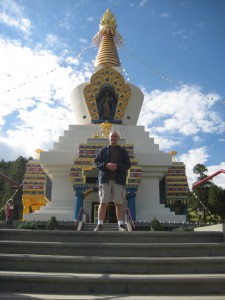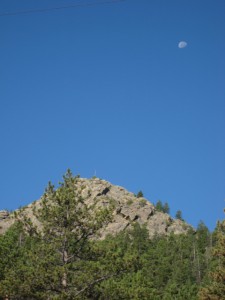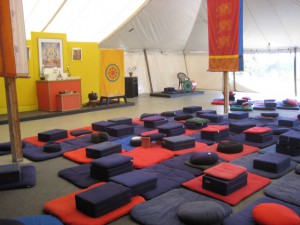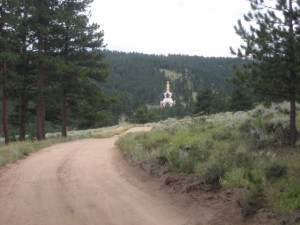Tuesday
Featured StoriesDathun – A Narrative
by Travis May
I am awakened by the blinding light of the sun. What good are see-through curtains? The powerful rays fill the room with a life-force that implores one to get out of bed. It’s 6:30am. I roll out of bed with the calm clarity that permeates the whole environment. Getting dressed and then going downstairs to get cleaned-up, I don’t encounter any of the other six house residents. Just as well, today there will be no talking.
I walk out onto the porch into the crisp summer air. It’s forty-five degrees. While making my way down the short path from the ranch house to the conference center, a small bunny freezes and stares at me cautiously as I pass. On the porch of the conference center, two chipmunks run down the railing and pause to watch as I enter the door. Here are the first signs of human life, some sitting scattered about at tables sipping coffee or tea, two reading the schedule on the bulletin board that I posted before going to bed the night before. *Silence All Day* it announces at the top under the date. Someone blows the conch shell; short, short, short, pause, short, short, short. This lets us know that it is seven minutes to seven. I put a jasmine tea bag into my cup and let the near boiling water pour over it.
Slowly making my way from the conference center to the shrine tent, I put the cup up to my nose and take in the fragrant scent of jasmine. I look up and to the left purposely to see the moon above the mountain in the deep blue daytime sky. The only sounds are the crunching of gravel under feet and the gong being struck in the PMH. The gatekeeper is reciting a four line chant in his head in between strikes of the gong.
At seven, the gatekeeper begins the rolldown, sixty some people taking off their shoes and lining up to go in. After the rolldown the umdze, or timekeeper, enters the shrine tent and the others follow. I walk in, take off my shoes, and go over to the trash can to deposit my tea bag. I enter the shrine tent, bow towards the shrine and am handed a chant book. At this point everyone is standing in front of their cushion waiting for the stragglers to get to their seat, the gatekeeper gonging more quickly now; grant your blessings so my mind may be one with the dharma (he says to himself), gong, grant your blessings so that dharma may progress along the path, gong, grant your blessings so that the dharma may clarify confusion gong. When everyone is at their places the umdze nods to the gekko who nods to the gatekeeper, who begins the final rolldown. The umdze starts to sit and everyone else sits down together.
It’s quite chilly. Many are bundled up in heavy jackets, scarves, and blankets. I don’t mind. There’s no place I’d rather be. The white tarp walls of the tent flap gently in the wind. Someone coughs, another clears her throat. The umdze strikes the gong three times indicating the beginning of the day’s practice. It won’t be completely silent on this day. The umdze chants The Four Dharmas of Gampopa solo. Everyone joins in on The Supplication to the Shambhala Lineage, then the Seven Line Supplication to Padmasambhava, The Supplication to the Takpo Kagyu, The Heart Sutra, and finally The Homage. The umdze strikes the gong one final time and meditation practice begins.
Trungpa Rinpoche first came here in 1971. Acharya Hayward said, “to have had that experience of knowing his mind filling all of space is especially important now that his physical body is no longer with us, because his mind has never moved.” He was like a conduit into a reality normally obscured by our conditioning that imprisons us like a cocoon. At Shambhala Mountain Center that window into the mind of the guru seems to have been left open.
I sit on the gomden, legs loosely crossed in front of me on the zabuton. My back is upright, head slightly tilted, gaze falling about six feet in front of me, eyes half-lidded, hands gently resting on my thighs. My mindfulness is loosely following my breath, my awarenss is watching to make sure it stays there, and to bring it back when it wanders. A thought tries to occupy my attention, but is gently brushed aside like a harmless fly. I am present. There is no need or desire to add any additional commentary or conceptual buffer to this moment. Then my awareness drops from my head down into my heart and the division between myself and the environment dissolves. What is left when the ego drops away, yet awareness remains? Seemingly, the totality, buddha nature, the universe, being aware of itself. Gong.
During his talk, Acharya Ferguson asks what we mean by the word ‘mindfulness.’ I answer, “mindfulness is reclaiming the lives we are actually living.” The always (overly) humble teacher recognizes the direct quote from his own book, hides a smile while bowing his head, and tries to move on to someone else as quickly as possible. If he had asked what exactly he meant by that, I may have said something like, “usually we spend our time lost in some story-line, some conceptual overlay that covers the direct experience of the present moment. In this way, we miss so much of our lives; stuck in the past or fantasizing about the future, we rarely take the time to Be Here Now,” as the famous Ram Dass book title commands.
After oryoki breakfast there will be a three-hour period of sitting and walking meditation. A big feature of this month-long meditation retreat is the extended periods of shamatha practice that allow the mind (hopefully) to settle further and further. Shamatha is a Sanskrit word (Tib. shine) that is translated as “peaceful abiding.” By repeatedly applying the technique of returning the attention to the breath and breaking the habit of continually being lost in thought, we develop the ability to tame the mind, somewhat, and to be present for the life that we are actually living. This process of taming the mind is likened to tilling the soil, so that then our innate seeds of joy, compassion, and wisdom may be cultivated through various other contemplative practices.
The afternoon session will mirror the morning in most respects. Except it has warmed up some. The meditation instructors are meeting individually with participants, so I will occupy the timekeeper’s seat. Once we are all seated, I strike the gong. The familiar tone reverberates through the air for half a minute and gently fades away. The smell of Japanese sandalwood incense wafts throughout the air. Then comes the rain. The sound is deafening on the tent top.
You can never actually see the present moment. By the time you look at it, it has passed and a new moment has arisen. The rain’s rat-a-tat-tat drumroll on the rooftop makes it easier to recognize that freshness and points out that you can’t hold on to any one of these moments, but if you can take the one trying to do the holding out of the equation, you can just ride along as part of the stream.
At eight o’clock the day’s activities are complete, and I decide to visit my favorite place on Earth. Out and up here, an hour away from the nearest city, the sky is black and illuminated by a billion stars. When I first came here last summer I used to take my flashlight with me to shine on the dirt path for the twenty minute walk through winding trails to the Great Stupa of Dhamrakaya. Now, I just walk alone in the quiet night with the moonlight as my guide. The stupa is a memorial to Trungpa Rinpoche. Skull fragments from his cremation rest in the heart-center of the giant twenty-foot gold Buddha statue inside the main sitting room. Relics of the historical Buddha, Milarepa, His Holiness the 16th Karmapa, and many other realized masters are embedded in the foundation.
After the traditional clockwise circumambulation of the structure I ascend the remaining steps to the entrance filled with veneration and appreciation for the great bodhisattva in whose honor this stupa was built. I prostrate three times to the beautiful monument, a symbol of the enlightened mind, in a gesture of offering and devotion. Finding the sitting room empty, I light an incense and take my seat in front of the great statue of the Buddha (the one who woke up). My head and heart vibrates with the electric energy of the room. An hour flies by in the blink of an eye. When I leave I feel rejuvenated, alive, and I dedicate any merit accumulated for the benefit of all sentient beings.
As I walk back I remember how loud the buzz of insects is in Florida. Here, at night, there is absolutely no sound. It’s amazing. It is cool again, the air crisp and sharp. I walk along the path. Trunpga Rinpoche was here, and neither was I.
This is the first piece in a series on Dathun: Experiencing Retreat</a> at the Shambhala Times. It was originally posted on Travis May’s blog as part of a larger piece, titled “Portait of a Shambhala Buddhist.“





















Oct 26, 2011
Reply
Thanks Lisa! I hope we can meet there again soon! xox
Oct 23, 2011
Reply
Travis,
This is beautiful…. thank you for sharing and bringing me back to SMC. I felt I was there again with every step.
Love and hugs
Lisa
Oct 22, 2011
Reply
Dear Kim,
Thank you for your message! I am glad you enjoyed the article and are benefiting from the practice. I definitely recommend making the two hour drive up to SMC! I wish I lived that close. You could even just go up for the day and visit the stupa.
Good Luck!
Travis
Oct 20, 2011
Reply
Hello Travis May,
I really enjoyed reading your post about the Mountain Center and Dathun. I became a Shambhala Member almost two years ago on Shambhala Day. I live in Denver, but I have never been to the Mountain Center and I certainly aspire to go as soon as I can make that happen. In the last three years I have lost two jobs and actually started coming to the Denver Center three years ago. I have really sought refuge and I am getting much from the practice. I plan on reading these little articles more. It was very inspiring.
Thank you,
Kim LaFleur